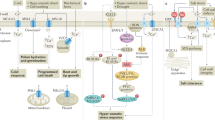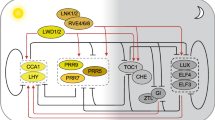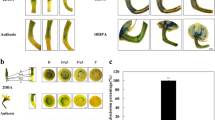Abstract
ALTHOUGH day-length is known to control flowering in some plant species, and a variety of vegetative responses, including dormancy, runnering and tuberization, in other species the relationship between these different types of photoperiodic effect is obscure. Evidence has been presented that the induction of dormancy in woody plants in response to short days involves the newly discovered growth-regulator, abscisin II (‘dormin’)1, and it has been possible to induce the formation of resting buds by application of endogenous inhibitor in birch2. Evans has recently reported the inhibition of flowering in the long-day plant, Lolium temulentum, by abscisin3. Thus it is pertinent to investigate whether abscisin II will stimulate flowering in short-day species. The availability of synthetic abscisin4 has made it possible to carry out a, range of experiments on this problem.
This is a preview of subscription content, access via your institution
Access options
Subscribe to this journal
Receive 51 print issues and online access
$199.00 per year
only $3.90 per issue
Buy this article
- Purchase on SpringerLink
- Instant access to full article PDF
Prices may be subject to local taxes which are calculated during checkout
Similar content being viewed by others
References
Cornforth, J. W., Milborrow, B. B., Ryback, G., and Wareing, P. F., Nature, 205, 1269 (1965).
Eagles, C. F., and Wareing, P. F., Physiol. Plant., 17, 697 (1964).
Evans, L. T., Science, 151 (1966).
Cornforth, J. W., Milborrow, B. V., and Ryback, G., Nature, 206, 715 (1965).
Robinson, P. M., and Wareing, P. F., Physiol. Plant., 17, 315 (1964).
Author information
Authors and Affiliations
Rights and permissions
About this article
Cite this article
EL-ANTABLY, H., WAREING, P. Stimulation of Flowering in Certain Short-day Plants by Abscisin. Nature 210, 328–329 (1966). https://doi.org/10.1038/210328a0
Published:
Issue date:
DOI: https://doi.org/10.1038/210328a0
This article is cited by
-
ABI4 regulates the floral transition independently of ABI5 and ABI3
Molecular Biology Reports (2018)
-
Promotive effect of abscisic acid in flowering ofChenopodium rubrum as the result of decreasing apical dominance
Biologia Plantarum (1981)
-
The differential effect of abscisic acid onChenopodium rubrum L. in dependence on growth and developmental state
Biologia Plantarum (1977)



